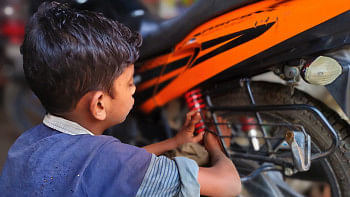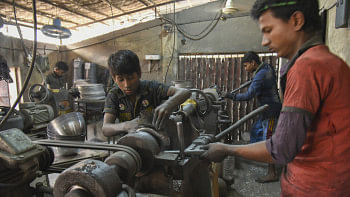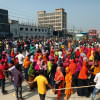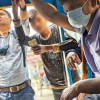Time to end the harmful practice of child domestic work

While the Asia-Pacific region has seen a sharp overall decline in child labour, Bangladesh's progress tells a more complex story, based on a report published by the International Labour Organization (ILO) and UNICEF on June 11. There has been a significant reduction in hazardous child labour in Bangladesh—from 3.2 percent in 2013 to 2.7 percent in 2022, affecting approximately 10.7 lakh children. However, the overall proportion of working children aged 5-17 years has slightly increased, from 8.7 percent to 8.9 percent during the same period. The rate of child labour involving harmful forms of work remained relatively stable, rising marginally from 4.3 percent in 2013 to 4.4 percent in 2022. These figures suggest that despite notable achievements over the past two decades—particularly in expanding school enrolment—Bangladesh is not on track to eliminate child labour by 2025.
Child labour harms children's education, violates their rights, and limits their opportunities for a better future. It also puts them at risk of physical and mental harm. Poverty and poor access to quality education are major reasons behind child labour.
According to the Bangladesh Labour Act, 2006 (amended in 2018), the minimum legal age for employment is 14. Children between 12 and 14 may only engage in "light work" that does not hinder their education or development. However, the law fails to clearly define what constitutes "light work." Most working children remain in informal employment. They often work long hours in poor conditions. The situation of child domestic workers is the worst.
The government has declared 43 types of work as hazardous for children—jobs that threaten their physical and mental development. Currently, 10.7 lakh children are engaged in hazardous work. The UN Committee on the Rights of the Child has expressed concern over Bangladeshi children working in welding, transportation, manufacturing, tobacco and battery factories. Child domestic labour is not on this hazardous work list, despite the obvious risks.
According to a March 2024 report by Bangladeshi Ovibashi Mohila Sramik Association (BOMSA), about 80 percent of the permanent domestic helpers are minor girl children. These children are denied access to education, healthcare, recreation, and protection. They perform almost every household chore—cleaning floors, washing dishes and clothes, cooking, and caring for younger children—often in exchange for basic food and shelter. Many are locked inside the house when employers leave for work, living in practical confinement.
Living far from their families in unfamiliar environments, child domestic workers are frequently subjected to physical, emotional, and even sexual abuse. A 2024 survey by Action for Social Development on child domestic workers in Dhaka revealed that nearly 50 percent experience some form of abuse, and 31.45 percent suffer from excessive workloads. Among those abused, 18.47 percent reported physical injury, 8.23 percent were beaten, 20.74 percent were verbally abused, and 1.7 percent experienced sexual abuse. If these conditions do not qualify domestic labour as "hazardous," then what does? All forms of child labour carry inherent risks, but the hidden and isolated nature of domestic work makes children even more vulnerable.
The Labour Act must clearly define "light work" and stipulate penalties for violations. Most importantly, employing children as domestic workers must be categorised as hazardous work.
The issue of removing children from hazardous jobs can be addressed through several strategies: improving household income, enrolling children in school and vocational training, and raising awareness among parents and employers about the harms of child labour. If children must work in limited, non-hazardous settings, then they should be supported through training that builds skills for a better future. Meaningful progress in eliminating child labour will require coordinated efforts from communities, employers, trade unions, civil society, NGOs, and the media.
Bangladesh has launched numerous national plans to eliminate child labour, but weak implementation and lack of political will have hindered meaningful progress. This must change.
We often accept child labour due to poverty while simultaneously celebrating our country's economic progress—this contradiction is telling. There are examples from other countries where child labour has been eliminated even in the face of extreme poverty, simply because society deemed it unacceptable.
In Bangladesh, most people consider child domestic labour normal. Many believe they are "helping" a poor child by offering food and shelter in exchange for work. But if someone genuinely wants to help, they should support the child's family financially so the child can stay in school. Exploiting a child's labour under the guise of charity is nothing more than opportunism.
We are shocked when we think of practices like slavery or the burning of women with their dead husbands (satidaha), which once had social acceptance. Shouldn't we be disturbed by the practices that exist today—where one child plays or attends school while another, the same age, labours in their household? Is this not a modern form of slavery?
As we speak of reform and progress in society, we must confront the deeply rooted and dehumanising acceptance of child domestic labour. It's time we recognised this practice for what it is: an inhumane tradition that has no place in a just society.
Laila Khondkar is an international development worker.
Views expressed in this article are the author's own.
Follow The Daily Star Opinion on Facebook for the latest opinions, commentaries and analyses by experts and professionals. To contribute your article or letter to The Daily Star Opinion, see our guidelines for submission.

 For all latest news, follow The Daily Star's Google News channel.
For all latest news, follow The Daily Star's Google News channel. 










Comments